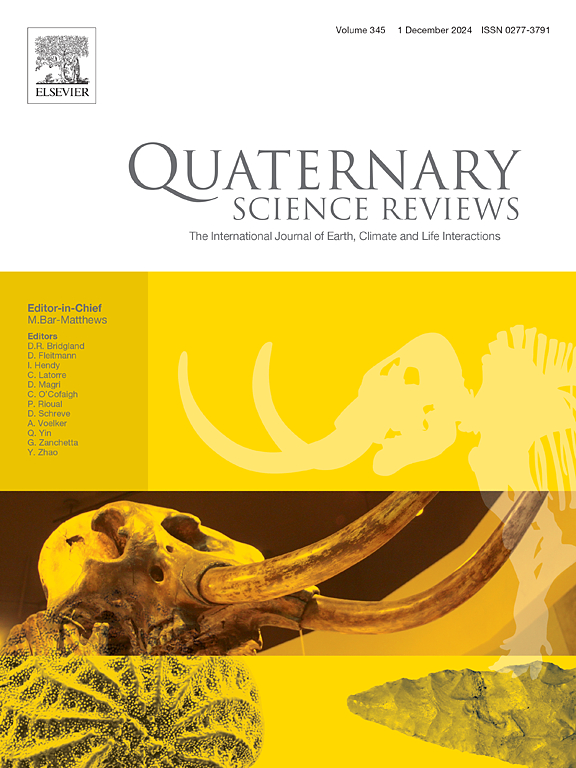Late middle Pleistocene malacological evidence of loess deposition in southeastern Poland and western Ukraine
IF 3.3
1区 地球科学
Q1 GEOGRAPHY, PHYSICAL
引用次数: 0
Abstract
About a dozen sites from the Late Middle Pleistocene, including loess attributed to MIS 6 (L2 loess) and MIS 8 (L3 loess), have been described in southeastern Poland and western Ukraine. Mollusc shells were found in thirteen profiles (four sites in Poland and nine in Ukraine). The occurrence of 26 taxa and over 22,500 specimens was recognised. The malacological analysis allowed us to distinguish five types of mollusc assemblages with different taxonomic composition and ecological structure, indicating the variability of depositional conditions of the discussed sediments. The defined assemblages were characterised by the occurrence of open-country taxa representing dry (Pupilla loessica, Pupilla muscorum and Vallonia tenuilabris) or humid (Succinella oblonga elongata and Trochulus hispidus) environments. Fauna typical of habitats with high humidity (with Vertigo genesii and Vertigo parcedentata) and aquatic (with Gyraulus laevis and Galba truncatula) occurred much less frequently. The ecological structure and taxonomic composition of the malacofauna occurring in the L2 and L3 loess showed great similarities. This implies similar climatic and environmental conditions on a sub-continental scale (Central Europe at the northeastern foreland of the Carpathians) during the Late Middle Pleistocene. In this context, the main contributors to the diversity of malacocoenoses are: (i) continental/regional factors (physical-geographical, climatic, i.e. succession of climatic phases: colder, warmer, drier and wetter, during glacial periods and related phases of intensified loess deposition interspersed with periods of increased pedogenesis), (ii) orographic/morphological barriers, and (iii) local conditions prevailing in specific geographical regions or even near the particular profiles (relief and microrelief, insolation, water conditions).
波兰东南部和乌克兰西部中更新世晚期黄土沉积的malacology证据
在波兰东南部和乌克兰西部,已经发现了大约12个中更新世晚期的遗址,包括属于MIS 6 (L2黄土)和MIS 8 (L3黄土)的黄土。在13个剖面中发现了软体动物壳(波兰4个,乌克兰9个)。发现了26个分类群和超过22500个标本。malacological分析使我们能够区分出五种类型的软体动物组合,它们具有不同的分类组成和生态结构,表明所讨论的沉积物的沉积条件具有可变性。已定义的组合的特点是,出现了代表干燥环境的开放国家分类群(黄蛹、musilla和Vallonia tenuilabris)或潮湿环境的长尾琥珀属(Succinella oblonga elongata)和长尾桃属(Trochulus hispidus)。典型的高湿度生境区系(有眩晕蝇和眩晕蝇)和水生生境区系(有湖回蝇和小圆蝽)的出现频率要低得多。2层和3层黄土中出现的软软动物群的生态结构和分类组成具有很大的相似性。这表明,在中更新世晚期,次大陆尺度上(喀尔巴阡山脉东北前陆的中欧)存在类似的气候和环境条件。在这种情况下,造成珊瑚群落多样性的主要因素是:(i)大陆/区域因素(自然地理、气候,即气候阶段的演替);更冷、更暖、更干和更湿(在冰川期和相关的黄土沉积强化阶段,间或有更多的成土作用),(ii)地形/形态障碍,(iii)在特定地理区域或甚至在特定剖面附近普遍存在的当地条件(地形和微地形、日照、水分条件)。
本文章由计算机程序翻译,如有差异,请以英文原文为准。
求助全文
约1分钟内获得全文
求助全文
来源期刊

Quaternary Science Reviews
地学-地球科学综合
CiteScore
7.50
自引率
15.00%
发文量
388
审稿时长
3 months
期刊介绍:
Quaternary Science Reviews caters for all aspects of Quaternary science, and includes, for example, geology, geomorphology, geography, archaeology, soil science, palaeobotany, palaeontology, palaeoclimatology and the full range of applicable dating methods. The dividing line between what constitutes the review paper and one which contains new original data is not easy to establish, so QSR also publishes papers with new data especially if these perform a review function. All the Quaternary sciences are changing rapidly and subject to re-evaluation as the pace of discovery quickens; thus the diverse but comprehensive role of Quaternary Science Reviews keeps readers abreast of the wider issues relating to new developments in the field.
 求助内容:
求助内容: 应助结果提醒方式:
应助结果提醒方式:


